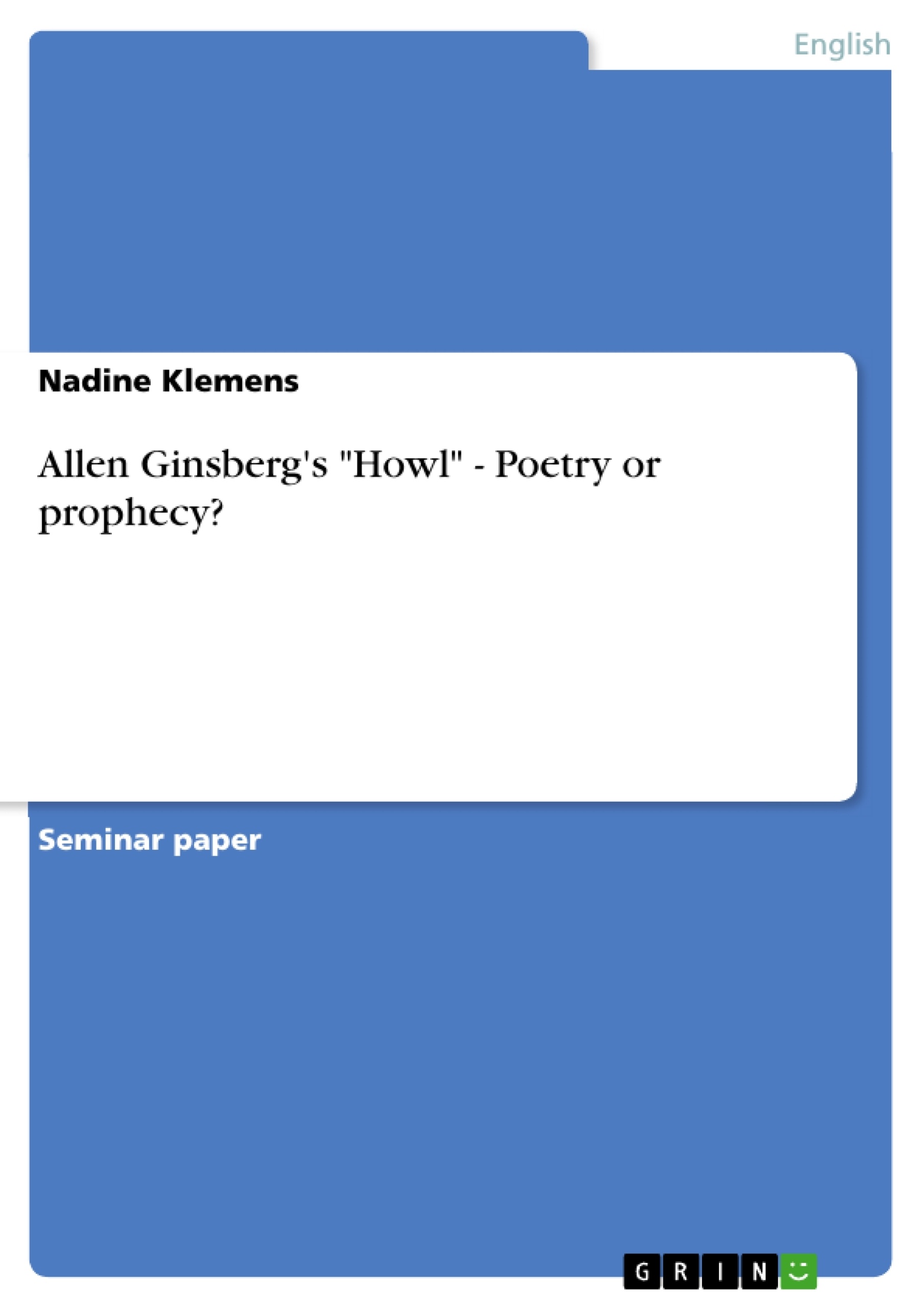Allen Ginsberg’s reputation as a major poet is now secure; he has outlived the other major poets of mid-century with whom he is frequently compared, such as Charles Olson, Robert Lowell, and Frank O’Hara, who with Ginsberg make up a core of writers that revolutionized the writing of American verse in the 1950s. […] Each of these major writers gave to the main currents of verse his own unique voice and intelligence, but it was Ginsberg especially who seems to have awakened America’s youth to the powers of poetry to make stirring prophecies and to reinvigorate the spheres of politics and ideology (Christensen 215). Allen Ginsberg was part of the Beat generation, a group of young authors, among them Lawrence Ferlinghetti, Jack Kerouac, William Burroughs, and John Clellon Holmes, who created a new and unconventional kind of literature. Ginsberg’s poem “Howl” is the most popular example of the innovative and provocative writing this group produced. Whereas Robert Lowell and other confessional poets wrote about their lives in a need to confess what was on their minds, Ginsberg went one step further and confessed the sins of a whole generation. “Howl” is a combination of autobiography , apocalyptic vision, catharsis, and prophecy. So what makes Allen Ginsberg and his poetry special? How was it possible that he awakened America’s youth and reinvigorated the political spheres? Why is his reputation as a major poet secure? How did he revolutionize poetry? In which way can he be called a prophet? And if he indeed was a prophet of his times, is his literary work consequently poetry or prophecy?
In order to scrutinize this question the goals of the Beat generation have to be defined: how was the term ‘beat’ coined? In the Beat movement, Ginsberg represented the prototype of a Beat writer and later became the guru of America’s youth. His tone of voice when reading “Howl” and his literary concept for his poetry illustrate the prophetic character of his work. For that matter, the book analyzes the three parts of “Howl” with regard to its rhythm and imagery.
Inhaltsverzeichnis
- Introduction
- The Beat Generation
- A Beat icon
- Literary inspirations
- The prophecy of a visionary poet
- Conclusion
- Works cited
Zielsetzung und Themenschwerpunkte
Diese Seminararbeit analysiert Allen Ginsbergs Gedicht "Howl" im Kontext der Beat Generation. Sie untersucht, inwiefern Ginsberg als visionärer Dichter und Prophet seiner Zeit betrachtet werden kann und analysiert die literarischen Einflüsse und Elemente, die "Howl" zu einem revolutionären Werk machen.
- Die Beat Generation und ihre Ziele
- Ginsbergs Rolle als Beat-Ikone und sein Einfluss auf die Jugend
- Ginsbergs literarische Inspirationen und die Einordnung von "Howl" in literarische Traditionen
- Die prophetischen Elemente in "Howl" und die Kritik an der kapitalistischen Gesellschaft
- Die Bedeutung von "Howl" als kathartisches Erlebnis und seine Relevanz für die Beat Generation
Zusammenfassung der Kapitel
Introduction
Die Einleitung stellt Allen Ginsberg als bedeutenden Dichter vor und beschreibt seinen Einfluss auf die amerikanische Jugend. Sie stellt die zentralen Fragen der Arbeit und die Vorgehensweise dar.
The Beat Generation
Dieses Kapitel beschreibt die Ziele und die Entstehung der Beat Generation. Es beleuchtet die Revolte der jungen Autoren gegen die konservative amerikanische Gesellschaft und ihre alternative Lebensweise. Die Bedeutung des Begriffs "Beat" wird im Zusammenhang mit Literatur, Musik und Lebensgefühl erläutert.
A Beat icon
Dieses Kapitel analysiert Ginsbergs Position innerhalb der Beat Generation und zeigt auf, wie er zum Prototyp des Beat-Schriftstellers wurde. Es untersucht Ginsbergs Interesse an Jazzmusik und seine Verwendung des "Typewriter Jazz" in seinen Gedichten. Zudem wird Ginsbergs Biografie beleuchtet und die Rolle der Insanity in seinem Leben und Werk hervorgehoben.
Literary inspirations
Dieses Kapitel analysiert die literarischen Einflüsse auf "Howl". Es zeigt die Parallelen zwischen Ginsbergs Werk und der biblischen Rhetorik sowie der Poesie Walt Whitmans auf. Die Verwendung von Obszönitäten und die autobiografischen Elemente in "Howl" werden im Vergleich zu Whitmans Werk "Leaves of Grass" betrachtet. Die Einordnung von "Howl" in die Tradition der pastoralen Elegie wird diskutiert.
The prophecy of a visionary poet
Dieses Kapitel analysiert die prophetischen Elemente in "Howl". Es untersucht die drei Teile des Gedichts und die darin enthaltene Kritik an der kapitalistischen Gesellschaft, die Ginsberg als "Moloch" personifiziert. Die Verwendung von Bildsprache und Rhythmus in "Howl" wird im Hinblick auf die prophetische Botschaft analysiert.
Schlüsselwörter
Die Schlüsselwörter und Schwerpunktthemen des Textes umfassen die Beat Generation, Allen Ginsberg, "Howl", Prophetie, Vision, Kapitalismuskritik, Urbanität, Jazz, Whitman, Bibel, Pastoral, Elegie, Insanity, Moloch, Catharsis.
- Quote paper
- Nadine Klemens (Author), 2003, Allen Ginsberg's "Howl" - Poetry or prophecy?, Munich, GRIN Verlag, https://www.grin.com/document/51835
-

-

-

-
Upload your own papers! Earn money and win an iPhone X. -

-
Upload your own papers! Earn money and win an iPhone X. -

-
Upload your own papers! Earn money and win an iPhone X. -

-
Upload your own papers! Earn money and win an iPhone X. -

-
Upload your own papers! Earn money and win an iPhone X. -

-
Upload your own papers! Earn money and win an iPhone X.

